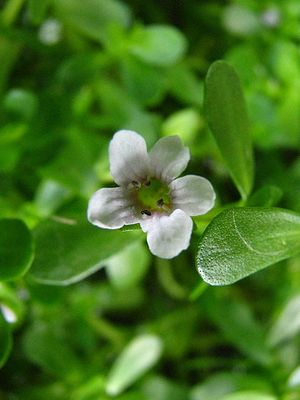Note: This is a project under development. The articles on this wiki are just being initiated and broadly incomplete. You can Help creating new pages.
Bacopa monnieri - Brahmi
Bacopa Monnieri is a non-aromatic herb. Its ability to grow in water makes it a popular aquarium plant. It can even grow in slightly brackish conditions.The whole herb is used medicinally in India in a variety of ways. Bacopa is a genus of 70–100 aquatic plants belonging to the family Plantaginaceae.
Uses
Epilepsy, Asthma, Ulcers, Tumors, Gastroenteritis, Ascites, Enlarged spleen, Anemia, Inflammations, Promote intellect, Memory enhancer, Increase life span, Rejuvinative.
Parts Used
Chemical Composition
Brahmi contains the alkaloids brahmine, herpestine. It contains saponins namely bacosides A and B. It also contains betulic acid, stigmasterol, monnierin and hersaponin. Bacosides A and B on hydrolysis gives triterpenoid aglycone bacogenins A and B respectively.[1]
Common names
| Language | Common name |
|---|---|
| Kannada | Brahmi, Brahmi |
| Hindi | Brahmi |
| Malayalam | Brahmi |
| Tamil | Neer brahmi |
| Telugu | Sambrani aku |
| Marathi | NA |
| Gujarathi | NA |
| Punjabi | NA |
| Kashmiri | NA |
| Sanskrit | Brahmi |
| English | Indian pennywort |
Properties
Reference: Dravya - Substance, Rasa - Taste, Guna - Qualities, Veerya - Potency, Vipaka - Post-digesion effect, Karma - Pharmacological activity, Prabhava - Therepeutics.
Dravya
Rasa
Tikta (Bitter), Kashaya (Astringent)
Guna
Laghu (Light)
Veerya
Sheet (cold)
Vipaka
Madhura (Sweet)
Karma
Prabhava
Habit
Identification
Leaf
| Kind | Shape | Feature |
|---|---|---|
| small | oval | leaves that are succulent and relatively thick, Brahmi leaves grow alternately on the soft hairy stem |
Flower
| Type | Size | Color and composition | Stamen | More information |
|---|---|---|---|---|
| Unisexual | white-purplish | five petals | Brahmi flowers bloom in most months of the year |
Fruit
| Type | Size | Mass | Appearance | Seeds | More information |
|---|---|---|---|---|---|
| oval | Brahmi fruit is oval and sharp at apexWith hooked hairs | {{{5}}} | {{{6}}} |
Other features
List of Ayurvedic medicine in which the herb is used
- Vishatinduka Taila as root juice extract
Where to get the saplings
Mode of Propagation
How to plant/cultivate
Plants can be grown in warmer temperate climates through to tropical zones[3]
Commonly seen growing in areas
Photo Gallery
References
External Links
- Ayurvedic Herbs known to be helpful to treat Epilepsy
- Ayurvedic Herbs known to be helpful to treat Asthma
- Ayurvedic Herbs known to be helpful to treat Ulcers
- Ayurvedic Herbs known to be helpful to treat Tumors
- Ayurvedic Herbs known to be helpful to treat Gastroenteritis
- Ayurvedic Herbs known to be helpful to treat Ascites
- Ayurvedic Herbs known to be helpful to treat Enlarged spleen
- Ayurvedic Herbs known to be helpful to treat Anemia
- Ayurvedic Herbs known to be helpful to treat Inflammations
- Ayurvedic Herbs known to be helpful to treat Promote intellect
- Ayurvedic Herbs known to be helpful to treat Memory enhancer
- Ayurvedic Herbs known to be helpful to treat Increase life span
- Ayurvedic Herbs known to be helpful to treat Rejuvinative
- Herbs with Root used in medicine
- Herbs with Stem used in medicine
- Herbs with Leaves used in medicine
- Herbs with common name in Kannada
- Herbs with common name in Hindi
- Herbs with common name in Malayalam
- Herbs with common name in Tamil
- Herbs with common name in Telugu
- Herbs with common name in Sanskrit
- Herbs with common name in English
- Habit - Herb
- Index of Plants which can be propagated by Seeds
- Index of Plants which can be propagated by Cuttings
- Herbs that are commonly seen in the region of Moist and wet places
- Herbs that are commonly seen in the region of Irrigated fields
- Herbs that are commonly seen in the region of Borders of water
- Herbs that are commonly seen in the region of Bank of Channels
- Herbs










